Yet while exhibition at the National Gallery of Victoria more than captures the myth and grandeur of the ancient Egyptian civilisation and its celebrated god-kings,it also attends to something quieter and more intimate:the lives of everyday people.
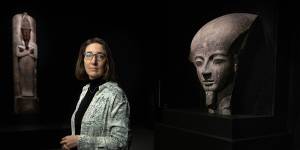
Marie Vandenbeusch,a curator from the British Museum,with a fragment of the sarcophagus lid of Pharaoh Ramses V.Simon Schluter
Take,for example,a statuette of the god Amun-Ra,created circa 1069-656 BCE. No taller than a Barbie doll,it would have been displayed in the innermost section of a temple and tended to by priests,whose role was to appease the pantheon of Egyptian gods through ritual and offerings.
As curator Marie Vandenbeusch explains,the object tells us a particular story about privilege and access in ancient Egyptian civilisation:“Temples were closed to most people – only certain types of priests and the kings were allowed in,” she says.
But the statue’s diminutive size meant that on particular occasions such as festivals,it could be carried out of the rarefied realm of the temple and into the lives of ordinary Egyptians,for whom it was the literal incarnation of a god. “I think it’s quite emotional to think of these daily rituals and beliefs.”
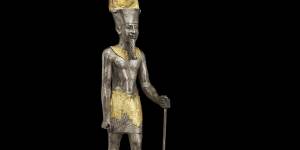
Statue of Amun-Ra,Karnak,Thebes,Egypt,Third Intermediate Period,about 1069-656© The Trustees of the British Museum
Pharaoh comes on loan from the British Museum,curated by Vandenbeusch specially for the NGV.
As an exhibition,it makes good use of scale. It recognises that the eye is greedy for monumental statues and towering sarcophagi,but then – through sophisticated staging by exhibition designer Peter King – skilfully directs attention to smaller,more intricate pieces.
Some spaces are sparse,expansive,lit warmly as though bathed in desert sunlight. Others are narrowed down through the use of partitions and dim lighting,recalling the shadowy interior of a tomb.
The scenography gives breathing space to artefacts that are breathtaking for their size and physical presence:a remarkably intact life-sized sculpture of Pharaoh Sety II,a phalanx of 10 lion-headed statues representing the goddess Sekhmet,an intricately decorated coffin base made for the afterlife of a temple doorkeeper. Wall projections offer glimpses of the sky in different aspects and undulating waters suggestive of the Nile,grounding the exhibition in a sense of place.
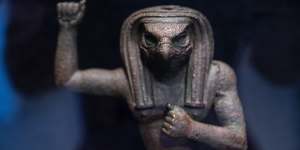
Detail of an exhibit of figures of a king and two gods in jubilation.Simon Schluter
There is one section entirely devoted to jewellery,which Vandenbeusch sees as “an exhibition within the exhibition”. Seldom displayed at the British Museum,these pieces reveal the level of craftsmanship and skill employed by Egyptian makers,as well as the role that jewellery and body adornment played in the lives of ancient Egyptians.
Blockbuster exhibition Pharaoh captures the myth and grandeur of the ancient Egyptian civilisation and it’s celebrated god-kings
“This was an amazing opportunity for me to explore this part of the collection,” explains Vandenbeusch. “These pieces are very intimate,because people wore them and it meant something to them:it was about beautification,but it was also about symbolism and meaning. I’m quite attracted by those small pieces,which tell a different level of stories.”
That said,Vandenbeusch has not neglected the titular pharaohs;the exhibition opens with a space that introduces the god-kings and their world. “It evolves through six different kings and six different objects,” Vandenbeusch explains. “I wanted people to encounter those pharaohs without preconceived ideas.”
One such idea is that all the pharaohs were male. Here,Vandenbeusch has selected a range of objects related to the life of Hatshepsut,who came to power following the death of her husband,the pharaoh Thutmosis II.
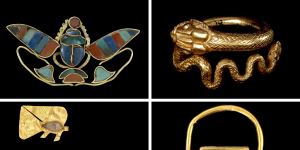
Jewellery from the exhibition,clockwise from top left:Ornament of a winged scarab holding a sun-disc;ring in the shape of a snake;ring showing Thutmose III as a sphinx trampling over an enemy;and amulets in the shape of a fish.Supplied
Hatshepsut ruled as pharaoh for more than 20 years and her reign was marked by peace and prosperity.
Yet in the decades following her death,monuments bearing her image were defaced and her name was quite literally erased from historical accounts – such as a stone tablet,featured in the exhibition,from which her name has been chipped off in a way to remove her from the chronology of pharaonic succession.
“It tells so much about what it meant to be a king,but also a woman in ancient Egypt,” Vandenbeusch says.
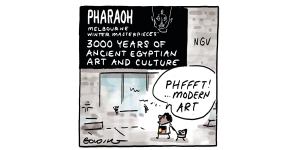
Matt Golding
For Vandenbeusch,it’s this sort of piece that offers the most insight into the ancient civilisation. “When you start looking at those objects,you get to the people,” she says. “That’s what I love about ancient Egypt – it’s not about pharaohs,it’s about people. And I think that’s what’s fascinating.”
is on at NGV International from June 14 to October 6.
The Booklist is a weekly newsletter for book lovers from books editor Jason Steger..
